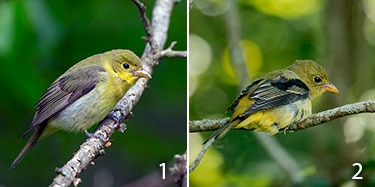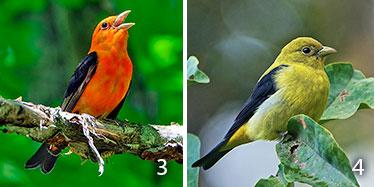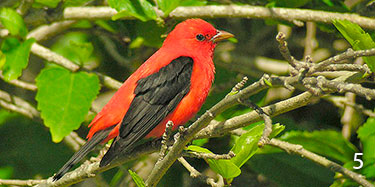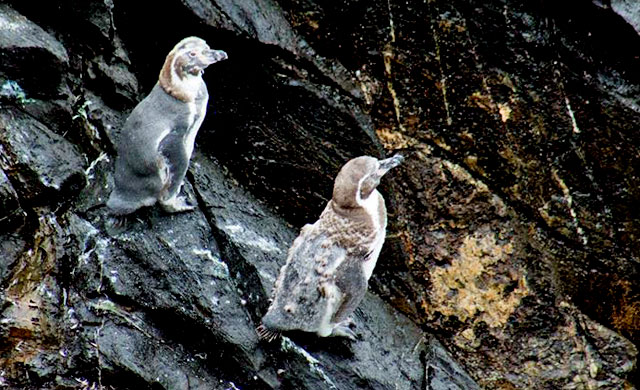
Molting is the process of replacing worn or damaged feathers in birds. Depending on the season, age, and gender of the individual, birds molt their feathers to acquire new plumage. Each species has evolved its molting strategy based on the environmental conditions they live in during each annual cycle.
In habitats and regions where feathers are subject to abrasion, fading, and wearing, birds tend to molt more often than in environments with mild conditions. Birds can have partial molts or replace all their feathers throughout the seasons.
Table of Content
- Why do Birds Molt?
- Bird Molting Terminology
- Molts through a Bird’s Life Cycle
- Molting of the Wing, Tail, & Body
- Molting Patterns
- Types of Molts
- Triggers of Molting
- Molting Frequency and Environment
- Molting and Parasites
- Energy Demands of Molting
Why do birds molt their feathers?
Feathers are made of keratin produced by specialized follicles or glands that create a new feather. Once the feather attains its full size, it remains attached to the follicle as a dead structure, which cannot regenerate itself. Therefore, worn feathers need to be replaced with fresh ones.
New feathers restore functional properties and provide bright colors that indicate the bird’s sex, age, and breeding conditions during a year cycle.
A feather is comparable to hair and nails in humans, which are also composed of keratin but unlike feathers, hair and nails regenerate themselves.
The plumage of birds that retain their plumage for a full year may change in appearance because of wear. Some birds may have spots after acquiring fresh plumage and lose them as the plumage wears down.
Bird Molt Terminology
Ornithologists Phillip Humphrey and Kenneth Parkes recognized the need for terminology for molts and plumages independent of environmental differences among seasons and regions. Ornithologists and birders widely use this terminology.
- Basic Plumage: The authors proposed that the plumage renewed after breeding be considered the basic plumage. The basic plumage is equivalent to the non-breeding plumage. Adult birds with only one plumage type always wear a basic plumage and molt from basic to basic for the bird’s life. Birds that molt more than once per year spend most of the year in the basic or non-breeding plumage.
- Alternate Plumage: The authors also propose that breeding adornments be considered a temporary addition or alternate plumage. The alternate plumage is equivalent to the breeding plumage. Birds generally spend only a small part of the year in this brighter and more colorful plumage.
Adult birds that have basic and alternate plumage molt from basic to alternate to basic repeated for the bird’s life. This is equivalent to saying that birds molt from non-breeding to breeding to non-breeding plumage, repeated for the bird’s life.

Molts Through a Bird’s Life Cycle
Molting varies among groups of birds and has environmental differences throughout the seasons. Small passerine birds (Cardinal, sparrows, juncos, and buntings) obtain their adult plumage in a single year, while gulls and some birds of prey take 2-4 years. Eagles and condors acquire their adult plumage in 5 years.
Hatchling to Juvenile: The first natal down of a hatchling consists of a few scattered down feathers, as in most hatchling landbirds, or a dense fuzzy covering like that of baby ducks and chickens. Down feathers seldom last more than a week or two. They are soon replaced by pennaceous feathers of the first basic plumage. Larger birds such as gulls, hawks, and eagles take much longer to obtain their first set of pennaceous feathers.
Juvenile to adult: The replacement of juvenile plumage by feathers that closely resemble adult birds involves most body feathers, though not always the wing and tail feathers. Young birds that undergo seasonal migrations from the breeding grounds tend to keep the first wing and tail feathers and use them to fly to the wintering grounds.
These birds will replace the first year or basic plumage, including the wing and tail feathers, when they return to the breeding grounds or just when they are over one year old. Gulls, hawks, and eagles replace their juvenile feathers for feathers that structurally resemble those of an adult bird but are very different. These birds take multiple years to attain the plumage of an adult.

Molting of the Wing, Tail, & Body Feathers
The knowledge of molt sequences in birds is better known in feathers of the wing and tail.
The molt of the wing and tail feathers are usually the most visible and easy to quantify because it leaves obvious gaps in flight and affects flight performance. On the other hand, body feathers are small, numerous, and similar in appearance.
While some birds, such as ducks, molt their flight feathers simultaneously, most adopt a more gradual molting approach. left off
- Primary Wing Feathers: The usual molt sequence for the primary flight feather starts from the innermost primary outward to the last feather of the wingtip. The molt of the secondaries and tail feathers tends to start once the primary molt is well advanced.
- Secondary wing Feathers: The normal molt of the secondary flight feathers typically commences in the innermost feathers (near the tertials) and works outwards. A second wave starts with the outermost secondary (next to the primaries) and works inwards in some species. However, there are numerous exceptions to this molting sequence. Many long-winged birds, such as albatrosses, have many secondaries and replace large numbers of them at once, diminishing flight performance.
- Tail Feathers: The tail molt usually is symmetrical, starting with the central pair of feathers and moving outwards. Birds that use their stiff tails for support, such as woodpeckers and woodcreepers, replace the central pair of feathers last, after the rest of the tail is fully grown and can help brace the bird while the central pair grows.
- Body or Contour Feathers: The timing and sequence of contour feathers are poorly documented. During the prebasic molt, contour feathers’ replacement generally overlaps with wing molt, but contour feathers on different parts of the body molt at slightly different times. In general, ornate feathers used in courtship displays are replaced last to have the best appearance at the start of the breeding season.
A Single Molt of Multiple Molts?
One complete molt a year was probably the primitive pattern from which more complex molt patterns evolved. One molt a year continues to be the typical molt pattern and is sufficient to offset normal feather wear rates.
Multiple molts per year have proved advantageous for some birds that perform courtship displays or adapt to severe feather wear or parasite load.
Some species have more than one complete molt a year, while others have complete molts and several partial molts.

Types of Molts
A few birds molt three or four times a year, but these molts are only partial ones.
The Ptarmigans live in habitats subject to changes in snow cover. To match their camouflage to the seasonal changes, they replace white feathers with brown ones when the snow cover recedes to eventually have brown plumage to blend in the snowless habitat.
Rock Ptarmigans (Lagopus muta) will partially molt into a completely white plumage at the winter month’s peak when the snow cover is at its maximum.
Birds such as geese have a single annual molt, while ducks of the northern temperate regions have evolved more unusual sequences that include:
- Prebasic Molt: It is the molt by which birds replace all of their feathers, usually occurring annually after breeding.
- Prealternate Molt: It is the molt by which birds replace only some and rarely all of the basic plumage feathers. The prealternate molt usually occurs before the breeding season and produces a bird’s handsome breeding plumage during courtship and pair formation.
The comparative studies of molts and plumage reveal that some species, such as the American robin, undergo only a single annual molt. In contrast, others, such as the scarlet tanager (Piranga olivacea), have a complex series of extra seasonal molts as follows:

Image 1: Year 1. In its first molt outside the nest, a juvenile male is olive-green with olive-brown wings and faintly streaked underparts.
Image 2: Year 1. After its first molts in the Fall (July-August), it resembles its unstreaked olive-green mother except for the black wing coverts that identify it as a male. Tim Lumley/Flickr/CC by 2.0

Image 3: Year 2: By May, it acquires a red-orange body plumage, but the black and brown wings signal its status as an immature male.
Image 4: Year 2: By the end of its second summer, it acquires its first adult basic plumage, olive-green plumage with jet black wing and tail feathers. Tim Lumley/Flickr/CC by 2.0

Image 5: Year 3: In spring, it acquires its first adult bright red breeding plumage. After breeding, the adult tanager molts into the basic plumage (Image 4), and every year before breeding, it molts into the bright red plumage again (Image 5). Tim Lumley/Flickr/CC by 2.0
Triggers of Molting
What triggers the sequential replacement feathers is still poorly understood. Possibly each follicle holding a feather has a different sensitivity to the seasonal hormones that trigger molt.
If so, feathers with the highest sensitivity would drop first. Adjacent follicles may interact, directly or indirectly, in association with the local expansion of blood vessels.
Molting Frequency and Environment
Some groups of birds have unique molting sequences that respond to the type and habitats that wear and abrade feathers sooner, requiring more frequent molting.
For instance, birds that live in deserts, where wind, solar radiation, and sand quickly wear feathers, molt twice a year. Birds that live in less extreme environments in Europe and are subject to less solar radiation and milder conditions suffer less abrasion and molt only once a year.

Molting and Parasites
Shedding parasites is one apparent result of molt frequency in some birds. Studies on parasite loads on two sparrow species living in grassland habitats found that the species that molted twice a year had a lower parasite load than the species that molted only once a year.
Birds that molt twice a year may do so to rid their bodies of parasites.
Energy Demands of Molting
The process of molting poses a significant energy demand. Hence, birds molt outside the breeding and migration seasons, which are regarded as the most energy-demanding parts of a bird’s annual cycle.
Large birds have multiple partial molting sequences, which are not very energetically demanding. Some of the partial molts may partly overlap with the breeding and migration periods.
Final Remarks
Feathers are unique to birds and are instrumental in their life cycle. Birds undergo long migration journeys, inhabit cold and harsh habitats, and communicate through feathers and plumages.
But feathers are composed of keratin, which means they cannot regenerate but must be replaced.
Birds have developed multiple strategies to replace their feathers ranging from partial molts of the body feathers to all-feathers-at-once in some species.
Learning about the basic concepts of molting in birds enables birders to understand the time of the year, age, and health and helps with bird identification.
Sources:
- Ellis, D. H.; Rohwer, V. G.; Rohwer, S. (2017). “Experimental evidence that a large raptor can detect and replace heavily damaged flight feathers long before their scheduled molt dates.” Ibis. 159 (1): 217–220.
- Frank B. Gill. 1990. Ornithology. W. H. Freeman and Company. New York.
- Humphrey, P.S., and K.C. Parkes. 1959. An approach to the study of molts and plumages. Auk 76:1–31.
LEARN MORE ABOUT BIRD BIOLOGY:





